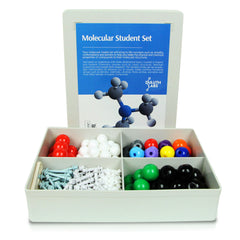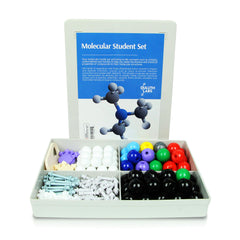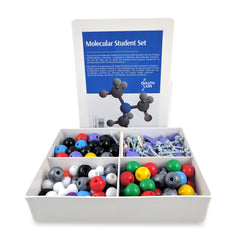Eucalyptol (Cineole):
Eucalyptol or Cineole is a colorless slightly water-soluble liquid. The chemical formula for Eucalyptol is C10H18O. It has a camphor-like odor and can be very pungent. This water-soluble liquid can be extracted from eucalyptus, cajeput and other essential oils. It is considered to be one of the defense molecules produced by plants to protect themselves from pests. It is capable of driving insects away, and was used to kill sandflies that carry with them the Leishmaniasis infection in Latin America.
Eucalyptol is also contained in flavoring agents. It is present in mouthwashes, cough sweets inhalants, toothpastes, due to its antibacterial effect.
Indeed, this molecule has a wide variety of uses, making it one wonder compound.
What does Eucalyptol look like in Chemistry?


Let’s Get Building!
Using your Student Molecular Model Set from Duluth Labs let’s create Eucalyptol! You’ll need:
-
10 Carbon Atoms
-
18 Hydrogen Atoms
-
1 Oxygen Atoms
-
18 Small connectors (compact small bonds for hydrogen)
-
12 Medium connectors (single covalent bonds)
-
Molecular Tool (for Disassembly)
Put aside all the atoms and connectors needed.
Let’s begin with building our bicyclic molecule. We’ll always start with the carbon at 12:00 position and build it in a clockwise direction. Are you ready?

Steps
-
1

1. First, get one carbon atom (Carbon 1), then attach a carbon atom (Carbon 7) to its right using a medium connector.
-
2

2. Connect another carbon (methyl) atom above Carbon 1 using a medium connector.
-
3

3. Add 3 hydrogens on this methylcarbon above Carbon 1 using 3 small connectors.
-
4

4. Similarly, add 2 hydrogens on Carbon 7using 2 small connectors.
-
5

5. Then using 1 medium connector, attach another carbon atom (Carbon 8) below Carbon 7.
-
6

6.Likewise, attach 2 hydrogen atoms on Carbon 8 using 2 small connectors.
-
7

7. Attach another carbon atom (Carbon 4) on Carbon 8 using a medium connector.
-
8

8. Using a medium connector, attach another carbon (Carbon 3) atom below Carbon 4.
-
9

9.With your 2 medium connectors, attach two methylcarbons below Carbon 3. In this case use 3 small connectors to attach 3 hydrogen on either methyl carbon.
-
10

10. Attach another carbon atom (Carbon 5) on Carbon 4 using a medium connector.
-
11

11. Attach 2 hydrogen atoms on Carbon 5 using 2 small connectors.
-
12

12. Use a medium connector to attach another carbon atom (Carbon 6) above Carbon 5.
-
13

13. Add 2 hydrogen atoms on Carbon 6 using 2 small connectors.
-
14

14. Connect Carbon 6 and Carbon 1 using a medium connector.
-
15

15. Now, get an oxygen atom and attach it to Carbon 1 using 1 medium connector.
-
16

16. Then, using a medium connector, attach this oxygen atom to Carbon 3.
-
17

17.Finally using a small connector attach a hydrogen atom to Carbon 4.
There you have it! We’ve just built another molecule – Eucalyptol!
We hope to see how your Eucalyptol (Cineole) molecule turned out!
Comment and share pictures below!
Tune in next week for another molecule of the week!
See you then xoxo :)
Afton Direct LLC
























doxycycline from canada
https://vslevitrav.com/ – generic levitra
Muchas gracias. ?Como puedo iniciar sesion?
Amoxicillin Dosage Children cobereva cheap cialis Reedeerb Kamagra Paypal Uk